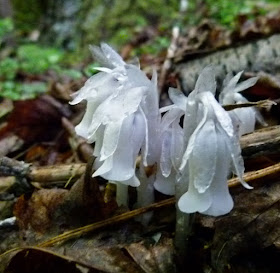When you hike through an "old growth" forest, you expect to see lots of trees, but the smaller plants are easier to see since they are closer to eye-level. If you gaze up at the large trees, you are guaranteed to trip on the roots, causing great damage to your hands and knees, let alone your camera when it hits the ground! So this post will focus on the ferns and fungi we found in the forest.
 |
| Stinkhorn Fungus |
The Kingdom Fungi includes some of the most important organisms, both in
terms of their ecological and economic roles. By breaking down dead organic
material, they continue the cycle of nutrients through ecosystems. In addition,
most vascular plants could not
grow without the symbiotic fungi, or mycorrhizae, that inhabit their
roots and supply essential nutrients. Other fungi provide numerous drugs (such
as penicillin and other antibiotics), foods like mushrooms, truffles and morels,
and the bubbles in bread, champagne, and beer.
 |
| Varnish Shelf Fungus and Pleasing Fungus Beetle |
Most fungi are saprophytes, feeding on dead or decaying material. This
helps to remove leaf litter and other debris that would otherwise accumulate on
the ground. Nutrients absorbed by the fungus then become available for other
organisms which may eat fungi. Many fungi are
parasitic, feeding on living organisms without killing them. Ergot, corn
smut, Dutch elm disease, and ringworm are all diseases caused by parasitic
fungi.
 |
| Magnolia Cone Fungus |
This magnolia cone fungi will only grow in dead fruits of magnolia trees. See the small filaments? If you dig under the leaves on the forest floor, these filaments look like little strings in every shovelful. Certain orchids cannot reproduce unless their seeds fall into ground containing specific fungi. We tend to think of fungi as undesirable in our homes or gardens, and between our toes, but nature depends on these lifeforms.
 |
| Coral Stemmed Fungus |
Although we usually picture the standard mushroom shape when we think of fungi, we only see the fruiting part of the organism above ground. They don't produce their own food, but can display bright colors or just dead looking white tissue. I'd love to know more about them, but I'd have to learn an entirely new language just to discuss their parts!
 |
| Indian Pipes |
You would think these white Indian Pipes were fungi as well, but they aren't. They lack chlorophyll, thus the white color, but has a mutual relationship with small, wood-rotting fungi that free nutrients for this plant's use.
 |
| Climbing Fern |
Walking in the old growth forest makes me think about the great swamps of the Pennsylvanian and Mississippian ages - the source of coal in Eastern Kentucky, which is our blessing and our curse.
In spots, we saw ferns growing waist-high along the trail....
 |
| Spleenwort in Rockface |
...while other small ferns grew only in the cracks of a vertical rockface.
Once we found a boggy spot with spaghnum moss and netted chain fern so thick you left a footprint if you stepped in it, so we didn't.
Ferns reproduce by spores found on the bottom of the fronds, and they can be used to help identify the species. Little bugs will curl up in a frond to lay their eggs. It's wonderful to see the inter-relationships in the forest.
Biodiversity is the key word to scientists and ecologists studying the Eastern Kentucky forests. The biodiversity of this region is greater than that of most of the other temperate areas in the world! If mountaintop removal continues, many of these species will be lost forever when their habitats are destroyed. They survived the ice ages, but may not survive the age of man.












Love all your pictures, especially the ferns.
ReplyDeleteWe have alot of different ferns growing on our property in SC mountains. Check out a few pictures I've posted.
Michael
Netted Chain Fern